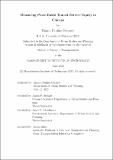Measuring Place-Based Transit Service Equity in Chicago
Author(s)
Swarney, Emma Pauline
DownloadThesis PDF (96.32Mb)
Advisor
Stewart, Anson F.
Abdelhalim, Awad T.
Terms of use
Metadata
Show full item recordAbstract
How to equitably distribute public transit service is a highly topical subject facing transit agencies operating in North America. Recent social movements have reignited the debate around Civil Rights on public transit and resulted in increased scrutiny of transit planning practices. While many agencies are striving to incorporate more progressive equity analyses, these equity assessment methods have several shortcomings. For example, they have not addressed important questions such as how service levels can be meaingfully compared between city areas differing in geospatial characteristics (e.g. residential neighborhoods versus Central Business Districts), and what a sufficient level of transit service should be for an area to be considered equitably served.
The goal of this thesis is to develop a new method for assessing place-based equity on a city-wide level, using Chicago and its transit system, the Chicago Transit Authority, as a case study. This method addresses several gaps in literature and practice, using historical passenger trips closely reflective of true system conditions, to measure the state of transit service. This thesis develops a method for determining what an equitable level of transit service should be while accounting for where an area is situated within the greater city geography.
This method is applied to two datasets from different time periods, September 2019 and October 2022. The two time periods are compared to understand if and how service quality has changed. Two types of analyses are performed on the data, one illustrating the service quality of all trips originating in an area, and the other to specific destinations, highlighting the strengths and weaknesses of the transit system. A quantitative equity score for each area in Chicago is presented, demonstrating a full execution of the method. The method is also applied to a project under proposal, the Red Line Extension, quantifying the projected equity benefits, and demonstrating how the method can be applied in different contexts.
Date issued
2023-06Department
Massachusetts Institute of Technology. Department of Urban Studies and PlanningPublisher
Massachusetts Institute of Technology